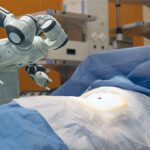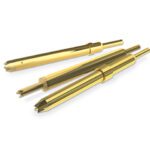Power Connectors for Medical Equipment Prioritize Safety
The first point of connection is the first opportunity to establish rigorous safety standards for medical technologies used in home healthcare and clinical settings. The base electrical standard for medical equipment, IEC/UL 60601-1, guides the design of safe and effective power supplies.
As medical equipment becomes more powerful, more portable, and more accessible to users with a wide range of training, it is imperative that electrical interfaces present no danger to patients or staff. In both complex medical environments and uncontrolled home environments, where medical care is increasingly occurring, a device that causes a short circuit or residual current can trigger a protective system upstream. In these events, the device could inadvertently shut down other, possibly critical equipment. Therefore, medical devices designers must pay special attention to how each unit is supplied with power.

Connectors and power entry modules used in medical equipment are tested to meet rigorous safety and performance standards. Components that are found in compliance with these standards can generally be used in most types of equipment without additional testing. Components used in medical equipment must meet the extensive requirements for safety defined in the base standard IEC/UL 60601-1. The IEC standards for electrical medical equipment are harmonized with UL so that the same requirements are in effect for equipment in North America.
Safe Power Feeds
Medical devices are typically either connected directly to wall power sources or mains, or configured to connect via a separable power cord that can detach from the equipment as well as the power source. These plug connections must meet the IEC 60320 standard for appliance couplers. Some applications may include a mechanism to protect against the unintentional removal of the plug from the equipment’s power socket. The most common type of protection against inadvertent disconnection is a cord-retaining bracket. Depending on the type of equipment, and to accommodate the wide range of types and shapes of power sockets in use, it is important to select a bracket shape that corresponds with the intended power socket.

SCHURTER’s V-Lock system features a hospital-grade plug. In this simple alternative to brackets, the power socket is equipped with a notch that interlocks with a special latch on the power cord connector, preventing the cord from being unintentionally pulled out of its socket.
Fuse Holders and Power-Line Filters Minimize User Risk
Many types of medical equipment feature integrated fuses. If there is a failure in a piece of equipment, a fuse prevents that unit from tripping the circuit breaker and disconnecting other, sometimes life-critical devices, from the power supply. Energized supply leads must be protected by a fuse. Some power distribution networks are not polarized, meaning that the power plug can be inserted in such a way that the energized conductor can be on either the plug’s left or right pole. Schuko plugs commonly used in Germany are one such example. As a result, the equipment fuse could be protecting the neutral conductor, which results in no protection against a short circuit to earth. To maximize protection, it is recommended that all medical electrical equipment be equipped with a double-pole fuse holder. In addition, operating policy must ensure that only authorized personnel can remove or replace fuses. The IEC/UL 60601-1 standard for medical electrical equipment specifies that fuse holders can only be opened up with the help of a tool.

Schuko plugs are commonly used in Germany. Schuko connectors are normally used on circuits with 230V and 50Hz for currents up to 16A.
The power-line filter is another central protective element in medical equipment systems. This element protects the equipment from external radio frequency interference (RFI) and reduces the interference radiated by the equipment. In Europe, a power-line filter is often necessary in order to fulfill the electromagnetic compatibility standards for Conformité Européenne (CE) declaration of conformity. As power-line filters may experience constant voltage, they are subject to strict requirements.
Avoiding Current Leakage
Capacitors wired between the power supply lines and earth within the power-line filter are known as Y capacitors. They produce a leakage current to earth whose value depends on the component’s capacitance and the power-line frequency. This fault current can, if too large, trigger the fault interrupter, whereby the power supply is shut off. Thus, touch leakage current for medical electrical equipment may not exceed 100μA under normal conditions, and for devices with direct patient contact, the maximum drops down to just 10μA. As a result, power-line filters for medical electric equipment do not have any Y capacitors, which results in a maximum leakage current of 5μA, or they have only very small Y capacitors, such as 470pF, which results in a peak leakage current of 80μA. However, it’s important to note that other components in medical equipment can also cause leakage currents, so it’s crucial to always measure the leakage current for the entire unit.

A compact C8 power socket by SCHURTER, featuring an EMC power-line filter for Protection Class II.
Managing Dielectric Strength in Medical Equipment
Medical equipment requires increased levels of dielectric strength to enable all connectivity products in the system. It’s essential to anticipate safety aspects related to material choices and design factors, including distances between voltages. The IEC/UL 60601-1 standard specifies clearance (air) and creepage (surface) distances of at least 3mm between energized parts of different polarities and 4mm between energized conductors and earth. It should also be noted that UL standards may allow for a smaller separation in these distances than IEC standards. Power sockets compliant with IEC 60320 fulfill medical requirements, while sockets compliant with UL 498 don’t have sufficient clearance and creepage distances to meet the requirements of IEC. The UL 498 standard for plugs and sockets specifies only a 1.2mm separation between energized parts of different polarities at a rated voltage of 250VAC max. In contrast, IEC 60320 requires 3mm for the same components, as does IEC/UL 60601-1.

SCHURTER’s high temperature inlet and cord connectors comply with IEC/UL 60320 and meet medical equipment requirements. This series is available with snap-in or screw-on mounting styles and the inlets can be specified with terminals for solder, quick-connect, or screw connections.
In the case of power-line filters, voltage separations inside the devices must also be observed. Here, too, the base electrical standard for medical equipment specifies 3mm between the energized phase conductor (L) and the neutral conductor (N), and it must be 4mm to earth. But, according to base standards for medical electrical equipment, these clearance and creepage distances can be reduced to some extent if the filter is potted.

SCHURTER’s 3-100-522 connector features V-Lock technology, meets IEC 60320-1, and can tolerate operating temperatures extending from -25°C to +70°C.
As a safety test, the base standard for electrical medical equipment specifies a high-voltage test of 1.5kVAC between L and N as well as between L/N and earth (PE). To PE, the 1.5kVAC corresponds to the values of the filter standard and can be met without any problem. However, filters between L and N should not be tested with 1.5kVAC because their capacitors could be damaged. IEC/UL 60601-1 makes an exception for interference-suppression capacitors, which can be removed for a high-voltage test if they have been tested to IEC 60384-14.

SCHURTER offers a variety of Class II power-line filters for medical equipment designed for home use.
Electrical equipment used in medical technology must fulfill high requirements in terms of safety to protect both patients and medical staff. While there are many design traits that contribute to said protection, it always begins with the safe supply of electric power.





